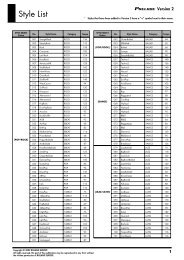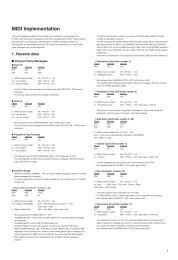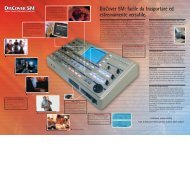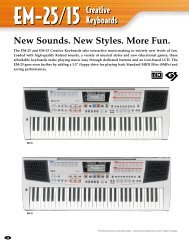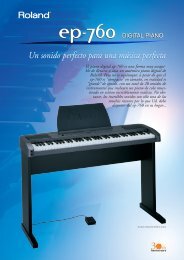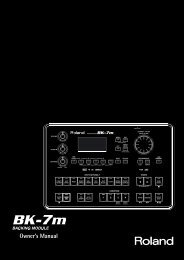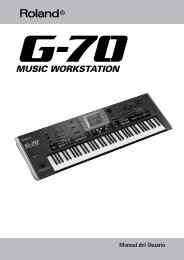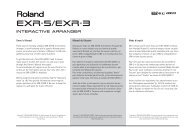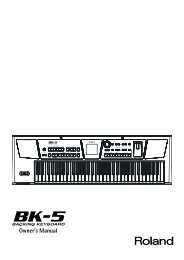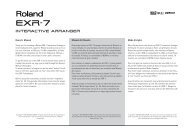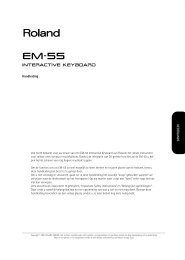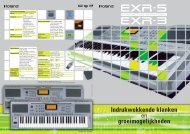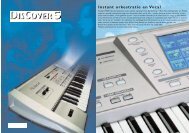Owner's Manual Manual del Usuario Mode d'emploi - Roland ...
Owner's Manual Manual del Usuario Mode d'emploi - Roland ...
Owner's Manual Manual del Usuario Mode d'emploi - Roland ...
You also want an ePaper? Increase the reach of your titles
YUMPU automatically turns print PDFs into web optimized ePapers that Google loves.
EXR-7s<br />
(4) To quickly return to the beginning of the accompaniment<br />
pattern (RE-START function), press the [REC≈∏]<br />
button while the accompaniment is running.<br />
(5) Play another chord (or note) to change the Arranger’s<br />
key.<br />
(6) Press the following buttons to use other patterns of<br />
the currently selected Music Style:<br />
Button Function<br />
INTRO* Playback of an introduction. Press this button<br />
before activating [START÷STOP].<br />
ORIGINAL Simple accompaniment version.<br />
FILL Transition (“Fill In”) to VARIATION or ORIGINAL.<br />
VARIATION Slightly more complex accompaniment version.<br />
ENDING* Phrase that indicates the end of the song. Use<br />
this button instead of [START÷STOP] to stop<br />
playback.<br />
(4) Interprete otro acorde (o nota) para cambiar la tecla<br />
<strong>del</strong> Arranger.<br />
(5) Pulse los siguientes botones para utilizar otros patrones<br />
<strong>del</strong> Estilo Musical actualmente seleccionado:<br />
Botón<br />
INTRO*<br />
Función<br />
Reproducción de una introducción. Pulse este<br />
botón antes de activar [START÷STOP].<br />
ORIGINAL Versión de acompañamiento simple.<br />
FILL Transición (“Relleno”) a VARIATION u ORIGINAL.<br />
VARIATION Versión de acompañamiento ligeramente más<br />
compleja.<br />
ENDING* Frase que indica el final de la canción. Utilice<br />
este botón en lugar de [START÷STOP] para<br />
detener la reproducción.<br />
(4) Jouez un autre accord (ou une autre note) pour changer<br />
la tonalité de l’arrangeur.<br />
(5) Appuyez sur les boutons ci-dessous pour utiliser<br />
d’autres motifs (“Pattern”) du style musical en vigueur:<br />
Bouton Fonction<br />
INTRO* Joue une introduction. Appuyez sur ce bouton<br />
avant d’activer [START÷STOP].<br />
ORIGINAL Version simple d’accompagnement.<br />
FILL Transition (“Fill In”) pour passer à VARIATION ou<br />
ORIGINAL.<br />
VARIATION Version d’accompagnement un peu plus<br />
sophistiquée.<br />
ENDING* Phrase indiquant la fin du morceau. Vous pouvez<br />
utiliser ce bouton au lieu de [START÷STOP]<br />
pour arrêter le jeu.<br />
RE-START<br />
ARRANGER<br />
M<br />
● REC<br />
These buttons select Music Style “patterns”. The icon corresponding<br />
to the button you press appears in the display<br />
(and the button you press lights).<br />
Also, the chord field in the display indicates the name of<br />
the chord you played last. This chord is used by the<br />
accompaniment.<br />
While the VARIATION and ORIGINAL patterns (as well as<br />
their ORCHESTRATOR versions) keep repeating the same<br />
accompaniment until you select another one, or until you<br />
stop Arranger playback, Fill-Ins (see above), Intros, and<br />
Endings are played only once.<br />
Estos botones seleccionan “patrones” <strong>del</strong> Estilo Musical.<br />
Aparecerá en la pantalla el icono correspondiente al botón<br />
que ha pulsado (y se iluminará el botón que ha pulsado).<br />
Además, el campo de acordes de la pantalla indica el<br />
nombre <strong>del</strong> acorde que reprodujo por última vez. Este<br />
acorde se utiliza mediante el acompañamiento.<br />
Mientras los patrones VARIATION y ORIGINAL (así como<br />
sus versiones ORCHESTRATOR) reproducen el mismo<br />
acompañamiento hasta seleccionar otro, o hasta detener<br />
la reproducción <strong>del</strong> Arranger, los Fill-Ins (consulte más<br />
arriba), Intros, y Endings sólo se reproducirán una vez.<br />
Ces boutons servent à choisir les “motifs” de style. L’écran affiche<br />
l’icône correspondant au bouton enfoncé (et ce dernier<br />
s’allume).<br />
En outre, la zone d’accord de l’écran indique le nom du dernier<br />
accord joué. Il s’agit de l’accord utilisé par l’accompagnement.<br />
Les motifs VARIATION et ORIGINAL (ainsi que leurs versions<br />
ORCHESTRATOR) répètent le même accompagnement<br />
jusqu’à ce que vous en choisissiez un autre ou que<br />
vous arrêtiez le jeu de l’arrangeur. En revanche, les motifs<br />
de transition (Fill-In, lisez ci-dessus), d’introduction (Intro)<br />
et de finale (Ending) ne sont joués qu’une seule fois.<br />
30



